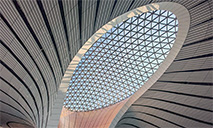"Drifters" bring new vitality to ancient Xinjiang city
URUMQI, March 25 (Xinhua) -- The ancient city of Kashgar, in southern Xinjiang, is home to one of the largest surviving group of earthen buildings in the world. Over the past decade, a group of young newcomers have settled down and injected vitality into the 400-year-old city.
Guoguo, a former soft furnishing designer in Shanghai, is one of these "drifters." After visiting Kashgar on a sketching expedition in 2018, he fell in love with the ancient city and decided to stay.
Now he and his wife run a store selling self-designed cultural products using traditional art skills and patterns.
For Guoguo, the historic city that stands on the ancient Silk Road is a living museum integrating both Eastern and Western civilizations. His understanding of the ancient city is embedded in his own artworks: Uygur patterns printed on the canvas, drawings of traditional dwellings on the paper made of morus bark, postcards with images of local musicians playing the rawap and the tambourine, as well as clay figurines of middle-aged Uygur men.
In 2019, he and many painting enthusiasts founded the "Urban Sketchers of Kashgar," a non-governmental organization aiming to portray the changing appearance of the ancient city. Now nearly 300 participants are involved in the organization, of which more than 100 are based in Kashgar.
To Guoguo and his peers, the former look of the ancient city was beyond belief. In an area of about 8 square km, there used to be over 200,000 people crammed into the primitive dwellings, which were vulnerable to natural disasters.
Kashgar's facelift began in 2010, when local authorities invested over 7 billion yuan (about 1.1 billion U.S. dollars) to refurbish the ancient city.
Within five years, 49,000 dilapidated houses were renovated under the premise of best preserving their original aesthetic. Today, the city not only provides local residents a more cozy, safer life, but also helps boost the local tourism industry, attracting new dwellers like Guoguo.
Li Jianhui, from Beijing, opened a 10-room hostel in the ancient city of Kashgar last year. "It's rare to have such a well-preserved ancient city that embodies the cultural elements of ethnic minority groups in China," said Li.
Yu Xiao and Wang Yunwang, from the central provinces of Hubei and Hunan respectively, are a couple. Yu provides photography services for tourists while Wang is a designer making traditional gold and silver jewelry. "We see great potential for the tourism industry in the ancient city," said Yu.
In the first 11 months of 2021, the ancient city of Kashgar received nearly 2.3 million tourists, up 183 percent year on year, with tourism revenue soaring by a whopping 486 percent. Many local residents have converted their houses into B&Bs, restaurants or handicraft shops to ride the wave of the burgeoning tourism industry, and see their life getting better and better.
Photos
 Increasingly more young adults in China register wills that include virtual assets
Increasingly more young adults in China register wills that include virtual assets Rapeseed flowers turn NW China's Luoping into picturesque spring wonderland
Rapeseed flowers turn NW China's Luoping into picturesque spring wonderland Why do people in China fall for animated characters like LinaBell and Bing Dwen Dwen?
Why do people in China fall for animated characters like LinaBell and Bing Dwen Dwen? Photo Album: architecture in Beijing merging history and modernity
Photo Album: architecture in Beijing merging history and modernity
Related Stories
- Xinjiang attracts investment projects with optimized business environment
- Wondrous Xinjiang: Young dream chaser and his ambition
- Palestinian officials condemn U.S. for lying on Xinjiang
- China's Xinjiang posts robust foreign trade growth in first two months
- Restoration project breathes life into world's largest natural populus euphratica forest
Copyright © 2022 People's Daily Online. All Rights Reserved.






